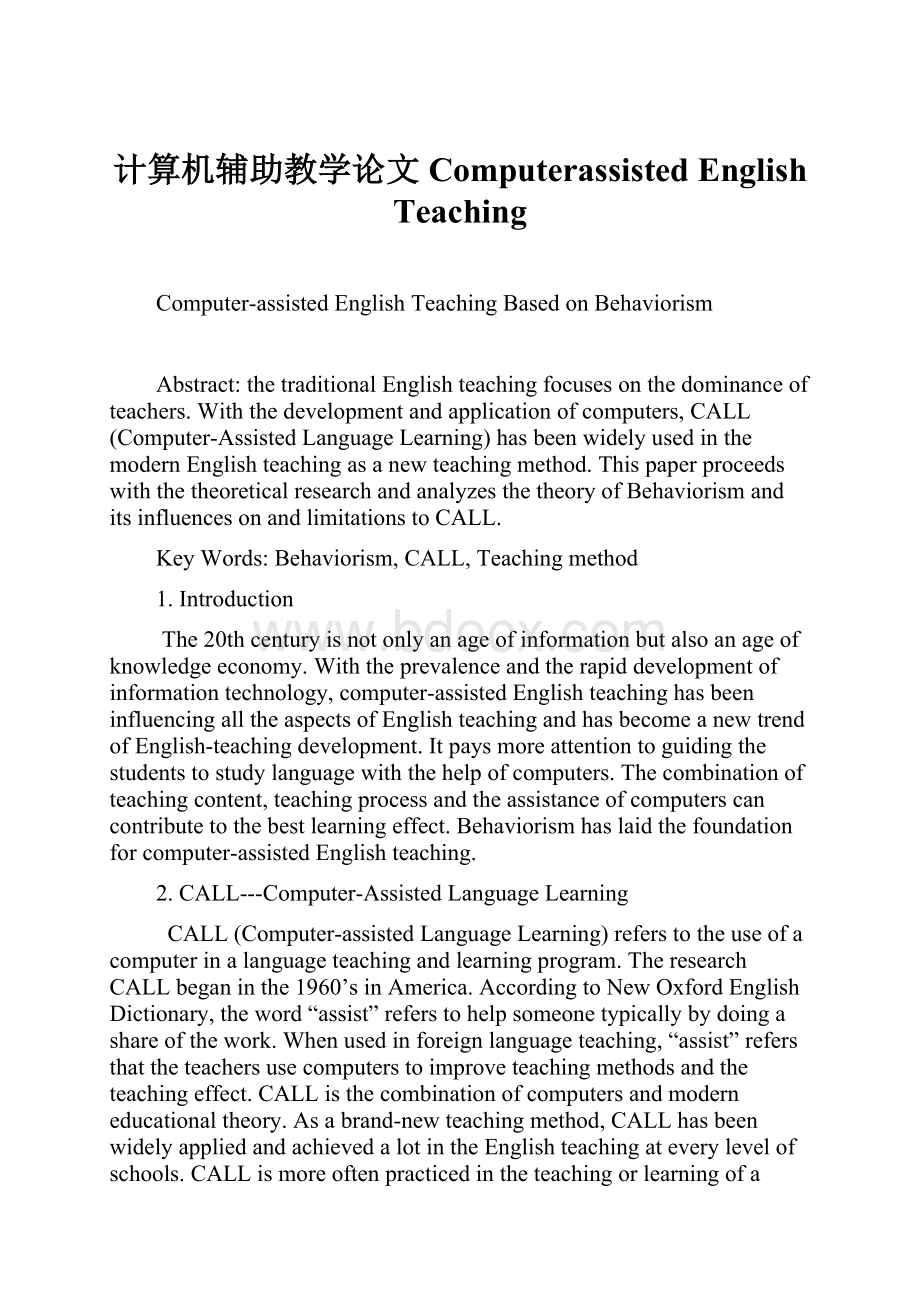计算机辅助教学论文 Computerassisted English Teaching.docx
《计算机辅助教学论文 Computerassisted English Teaching.docx》由会员分享,可在线阅读,更多相关《计算机辅助教学论文 Computerassisted English Teaching.docx(8页珍藏版)》请在冰豆网上搜索。

计算机辅助教学论文ComputerassistedEnglishTeaching
Computer-assistedEnglishTeachingBasedonBehaviorism
Abstract:
thetraditionalEnglishteachingfocusesonthedominanceofteachers.Withthedevelopmentandapplicationofcomputers,CALL(Computer-AssistedLanguageLearning)hasbeenwidelyusedinthemodernEnglishteachingasanewteachingmethod.ThispaperproceedswiththetheoreticalresearchandanalyzesthetheoryofBehaviorismanditsinfluencesonandlimitationstoCALL.
KeyWords:
Behaviorism,CALL,Teachingmethod
1.Introduction
The20thcenturyisnotonlyanageofinformationbutalsoanageofknowledgeeconomy.Withtheprevalenceandtherapiddevelopmentofinformationtechnology,computer-assistedEnglishteachinghasbeeninfluencingalltheaspectsofEnglishteachingandhasbecomeanewtrendofEnglish-teachingdevelopment.Itpaysmoreattentiontoguidingthestudentstostudylanguagewiththehelpofcomputers.Thecombinationofteachingcontent,teachingprocessandtheassistanceofcomputerscancontributetothebestlearningeffect.Behaviorismhaslaidthefoundationforcomputer-assistedEnglishteaching.
2.CALL---Computer-AssistedLanguageLearning
CALL(Computer-assistedLanguageLearning)referstotheuseofacomputerinalanguageteachingandlearningprogram.TheresearchCALLbeganinthe1960’sinAmerica.AccordingtoNewOxfordEnglishDictionary,theword“assist”referstohelpsomeonetypicallybydoingashareofthework.Whenusedinforeignlanguageteaching,“assist”refersthattheteachersusecomputerstoimproveteachingmethodsandtheteachingeffect.CALListhecombinationofcomputersandmoderneducationaltheory.Asabrand-newteachingmethod,CALLhasbeenwidelyappliedandachievedalotintheEnglishteachingateverylevelofschools.CALLismoreoftenpracticedintheteachingorlearningofasecondorforeignlanguage.AccordingtoRichards,etal.(1998),itmaytaketheformof:
a.activitieswhichparallellearningthroughothermediabutwhichusethefacilitiesofthecomputer(e.g.usingthecomputertopresentareadingtext);
b.activitieswhichareextensionsoradaptationsofprint-basedorclassroom-basedactivities(e.g.computerprogramsthatteachwritingskillsbyhelpingthestudentdevelopatopicandthesisstatementandbycheckingacompositionforvocabulary,grammar,andtopicdevelopment);
c.activitieswhichareuniquetoCALL.
3.PhrasesofCALLDevelopment
Therearemainly4phrasesinthecourseofCALLdevelopment.
3.1PhraseⅠ(BehavioristicCALL)
TheBehavioristicCALLwasconceivedinthe1950sandimplementedinthe1960sand1970s.Programsduringthisperiodcanbereferredtoas“drillandpractice”.Theprinciplesbehindthiscomputerastutormodelcouldbebrieflyputasfollows:
a.Repeatedexposuretothesamematerialisbeneficialorevenessentiallearning.
b.Acomputerisidealforcarryingoutrepeateddrills.
c.Acomputercanpresentmaterialonanindividualizedbasis,allowinglearnerstoproceedattheirownpaceandfreeingupclasstimeforotheractivities.
Inthelate1970sandearly1980s,BehavioristicCALLwasunderminedbytwoimportantfactors.First,behavioristicapproachestolanguagelearninghadbeenrejected.Secondly,theintroductionofthemicrocomputerallowedawholenewrangeofpossibilities.
3.2PhraseⅡ(CommunicativeCALL)
TheCommunicativeCALLismarkedbythefactthatsmallcomputersappearedandtheprogramscouldbestoredontapesorfloppydisksandthewholesystemwasportable.
Pedagogically,thisphrasewasbasedonthecommunicativeapproachtoteachingwhichbecameprominentinthe1970sand80s.SeveraltypesofCALLprogramsweredeveloped.
First,avarietyofprogramsrepresentanextensionofthecomputerastutormodel.ThesecondCALLmodelisthecomputerasstimulusmodel.Thethirdmodelofcomputersinvolvesthecomputerastoolorthecomputerasworkhorseapproach.Butbytheendofthe1980s,theCALLwasfailingtoexist.
3.3PhraseⅢ(IntegrativeCALL)
ThelearningfeaturedbytheIntegrativeCALLwasnotsomuchsuppliedbythelanguageofthetextitselfasbythecognitiveproblemsolvingtechniquesandinteractionbetweenstudentsinthegroup.
Thiswasmadepossiblebytheimportanttechnologicaldevelopmentofmultimediacomputerandinternet.Whatmakesmultimediamorepowerfulisthatitalsoentailshypermedia.
Computer-mediatedcommunicationallowsuserstosharenotonlybriefmessages,butalsolengthy(formattedorunformatted)documents---thusfacilitatingcollaborativewriting---andalsographics,soundsandvideo.
3.4PhraseIV(IntelligentCALL)
Asnewtechnologybecomesahouseholdnecessity,languageteachingusingsuchmeanswilldoubtlessbecomemorewidespread.SomeworkhastakenplaceonintegratingCALLwiththemoreorthodoxideasoflearning,leadingtoICALL(InternetCALL).
4.BehaviorismTheory
BehaviorismTheoryisalsocalledStimulus-ResponseTheorywhichisoneofthemainlearningtheories.ThefounderofStimulus-ResponseTheoryisJohnB.Watson(1878-1958).Behaviorismholdsthathuman’smindresultsfromtheinteractionoftheouterenvironment,whichis“stimulus-response”.Thejointbetweenstimulusandresponseis“reinforcement”.BehaviorismLearningTheoryregards“reinforcement”asthecoreofteachingprocedure.Itholdsthatonly“reinforcement”canleadtothebestlearningenvironmentandenhancestudents’learningmotivation.
AccordingtoBehaviorismLearningTheory,teachingcontentshouldbedecomposedintoaseriesofsmallteachingunitsandshouldbelearnedwiththehelpofteachingunits.Onlyinthiswaycanthefrequencyofreinforcementbeincreasedtothelargestextentandcanthenegativeresponsecausedbymistakesbedecreasedtothesmallestextent.ThecoursewarewhichisdesignedonthebasisofSkinner’scondition-responseexperimentandtheprincipleofstimulus(question)---response(answer)---enforcement(confirmation)makesadifferenceinoptimizingclassteaching.
Behaviorismistheschoolofpsychologythatdefinespsychologyasthestudyofobservablebehaviorandstudiesrelationshipsbetweenstimuli(S)andresponses(R).ThefirstphaseofCALL,conceivedinthe1950sandimplementedinthe1960sand1970s,wasbasedonthedominantbehavioristtheoriesoflearningandteachingofthetime,whichemphasizesthespokenratherthanthewrittenformandpresentsthelearneracarefullygradedseriesofhabit-formingmodesoflearning.Programsofthisphaseentailrepetitivelanguagedrillsandcanbereferredtoas“drillandpractice”.Drillandpracticecoursewareisbasedonthemodelofcomputerastutor.Inotherwords,thecomputerservesasatutoringdevicethatissuesinstructionalmaterialtostudents.BehavioristicCALLessentiallyprovidespracticeforgrammarandvocabularyacquisition.Inthelate1970sandearly1980s,behavioristicCALLlostitspopularityfortwomainreasons,namely,changesinapproachestolanguageteachingandtheinventionofthemicrocomputer.
TherearealsosomeprinciplesinteachingprocedureandtheyareimportantinCALLcoursewaredesign:
a.Shot-stepprinciple.Itreferstodividethelearningcontentintosmallunitsandsequencethemaccordingtotheirlogicandformproceduraltextsandcourseware.Studentsstudyfromtheeasytothedifficultgradually.
b.Active-responseprinciple.AccordingtoSkinner,traditionalteachingfocusesonteachers’roleinimpartingknowledgeandstudents’passiverole.Studentshavefewchancestorespondteachers’questions.Inordertochangethepassivelearning,thecoursewareshouldbedesignedaccordingtothestudycontentofeveryunittostimulatestudentstorespondactive.
c.Immediate-enforcementprinciple.Whenstudentsrespondtoteachers,teachersshouldimmediatelymakestudentsknowwhethertheyareright.Thecoursewareshouldgiveimmediateenforcetostudentssoastoenhancetheirperformance..
d.Self-pacedprinciple.Inthetraditionalteaching,thepaceoflearningisidentical,whichgreatlylimitsthefreedevelopmentofstudents.Computer-assistteachingiscenteredonstudentssothattheycansettheirownlearningpaceaccordingtotheirownsituation.Properpacesandenforcementgivestudentsfurtherlearningpower.
e.Low-error-rateprinciple.Thetextsshouldbearrangedfromtheeasytothedifficultandfromtheunknowntotheknownsothatstudentscanhavemorerightresponseandenhancelearningefficiency.
5.TheApplicationofBehavioristicCALL
AccordingtoWarschauer(1996),inthephaseofBehavioristicCALLfromthe1960’stothe1970’s,computersareregardedareaninexhaustiblemachineinstructorwhorepeatedlyprovideslanguageexerciseandresponseforstudentssothatstudentscanstudyagainandagainaccordingtotheirownpaceofstudy.Accordingtotheprincipleof“stimulus---response---enforcement”,CALLisusedinEnglishteachinginthefollowingaspects:
a.CALLcanprovidediversifiedexternalstimulusandenlightenstudents’Englishthinkingability,whichisbeneficialforthemtoacquireandkeeptheirknowledge.Multimediatechnologyprovidescombinedenvironment.Itshowsvisibleandaudibleinformationwithlivelyandvariousforms.Thismulti-levelexpressionsanddiversifiedsensorystimuliareeffectivetoEnglishstudy.Inthisenvironment,languagelearnerscanhaveactivepsychologicalexperienceandtheycanimmediatelytransformitintothedesireofknowledge.Inthisway,theycanacquiremuchmoreinformationthanwhatisacquiredinclass,whichismorebeneficialtokeepandtransformtheirknowledge.
b.Thecoursewarethroughmultimediatechnologyisvivid,livelyandmoresuitabletoarousestudents’interestinEnglishle